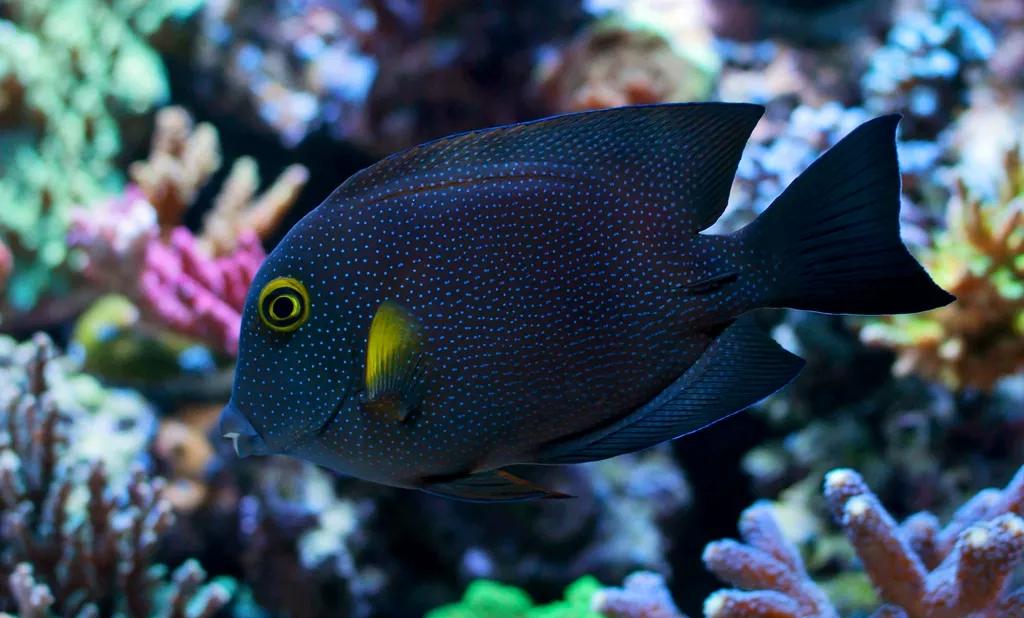The Indian golden hoop crane is named after its short caudal fin, which does not have the elongated, pointed shape typical of other members of the genus. They also have a special and prominent mouth with rows of soft bristles or comb-like teeth that scrape all kinds of algae and debris from rocks, sand, and other surfaces, and then suck up food with their mouths.

The overall color of the Indian gold ring hanging adult fish is brown, the body is covered with small dots of light blue, and the eyes have a gold eye. The pectoral and ventral fins are yellowish brown, the dorsal, and caudal fins are the same color as the body, and the ventral, dorsal and fins are blue at the edges.
Juveniles are yellow overall, with blue edges on the dorsal and fins, and as they grow, the body slowly darkens in color and shows small, fainter dots. Aquarists sometimes confuse it with their Pacific cousin, the Yellow-Eyed Crane, because of their similar color. Both species in the adult stage have yellow eye circles and yellow dorsal fins, but the body of the Indian golden circle crane is covered with small pale blue spots, while the yellow eye crane has small spots on the head, and the rest have pale blue horizontal stripes.
Indian golden hoop cranes are found in the Indian Ocean, from the east coast of Africa to West Java and from the north to the Andaman Sea. They inhabit coral reef tops and slopes. Found in its natural habitat usually live at depths of 1-21 meters. Juveniles usually appear in loose groups, while adults usually move in pairs.
<h1 class= "pgc-h-arrow-right" > the diet of the Indian golden circle hanging</h1>
Indian golden hoop cranes are considered herbivorous fish, and in the wild, they feed on detritus, as well as flagellar, diatoms, benthic weeds and a large number of other organic matter.
In our sea tanks, most of the diet of the Indian Golden Circle Crane will come from microscopic algae and detritus that grow naturally, and will grow better in environments with plenty of reefs and bottom sand. But this food source may not be enough to sustain their daily needs, so in order to boost their body's immunity, reduce aggressive behavior, and improve their overall health, they must also be provided with complementary foods.
It is relatively easy for the Indian golden hoop crane to open its mouth to eat most of the prepared sea tank food. Most of what they ingest is plant-based, but they also need some meat. Vegetarian diets containing seaweed or spirulina, frozen brine shrimp and flaky foods are all good choices. You can use vegetable clips to glue seaweed or other seaweed to the aquarium glass or tie dried seaweed to the stone to feed, it is recommended to eat less and eat more than 3 times a day.
<h1 class="pgc-h-arrow-right" > the compatibility of the Indian gold ring crane</h1>
In our tanks, indian golden hoop cranes need more than 280 liters of sea tanks to provide enough room for their movement, it is recommended to raise them with other peaceful reef fish, and usually do not disturb invertebrates. But polyculture with other aggressive hoisting species can be troublesome and often become a victim. Don't get sick with aggressive fish because they can be stressed.
However, in large aquariums, they can be raised with other cranes (such as sail wing inverted cranes), but before putting them into the main tank, it is recommended to use isolation boxes, partitions or similar methods, especially when there are already larger or raised cranes in the tank for a period of time.
<h1 class="pgc-h-arrow-right" > disease protection</h1>
Compared to other marine fish, hanging skin produces less mucus, and some people jokingly call them "dry-skinned" fish. This makes them very susceptible to bacterial diseases, head hole diseases, lateral line diseases and marine white spots, helminth infections.
It is routine to use isolation tanks to provide a stress-free environment accompanied by high-quality vegetarian food. The use of vitamin supplements, including vitamin C, can help meet the nutritional needs of fish, and vitamin C can help reduce lateral line erosion. Foods can be enriched by soaking dried granules with liquid vitamins, adding vitamins to food, or adding liquid vitamins to water.
While most amateurs opt for the more common "yellow-eyed crane", the Indian gold hoop crane may be a better choice for our sea tanks. They are beautiful, lively fish that can provide more fun and practicality for aquarists' aquariums.